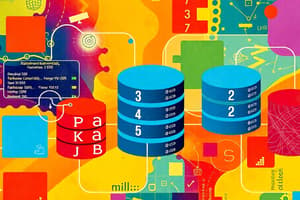Podcast
Questions and Answers
What is the purpose of a Database Management System (DBMS)?
What is the purpose of a Database Management System (DBMS)?
To manage and organize data in a structured manner.
Explain the role of Data Modeling in a DBMS.
Explain the role of Data Modeling in a DBMS.
Data Modeling defines the structure and relationships of data in a database.
What key feature of a DBMS is responsible for storing and retrieving data?
What key feature of a DBMS is responsible for storing and retrieving data?
Data Storage and Retrieval.
How does a DBMS ensure multiple users can access data without conflicts?
How does a DBMS ensure multiple users can access data without conflicts?
What tools does a DBMS provide for enforcing data integrity and security constraints?
What tools does a DBMS provide for enforcing data integrity and security constraints?
In the event of a system failure, what mechanism does a DBMS provide for recovering data?
In the event of a system failure, what mechanism does a DBMS provide for recovering data?
Explain the difference between RDBMS and NoSQL DBMS in terms of data storage.
Explain the difference between RDBMS and NoSQL DBMS in terms of data storage.
What was the name of the first RDBMS and who developed it?
What was the name of the first RDBMS and who developed it?
In what decade was the Structured Query Language (SQL) developed?
In what decade was the Structured Query Language (SQL) developed?
What do object-oriented database management systems (OODBMS) combine?
What do object-oriented database management systems (OODBMS) combine?
What was the main focus of NoSQL databases when they emerged in the 2000s?
What was the main focus of NoSQL databases when they emerged in the 2000s?
What is one key advantage of cloud-based database systems?
What is one key advantage of cloud-based database systems?
Study Notes
A Database Management System (DBMS) is a software system designed to manage and organize data in a structured manner. It allows users to create, modify, and query a database, as well as manage the security and access controls for that database. DBMS provides an environment to store and retrieve the data in an organized and efficient manner.
Key Features of DBMS:
- Data Modeling: A DBMS provides tools for creating and modifying data models, which define the structure and relationships of the data in a database.
- Data Storage and Retrieval: A DBMS is responsible for storing and retrieving data from the database, and can provide various methods for searching and querying the data.
- Concurrency Control: A DBMS provides mechanisms for controlling concurrent access to the database, to ensure that multiple users can access the data without conflicting with each other.
- Data Integrity and Security: A DBMS provides tools for enforcing data integrity and security constraints, such as constraints on the values of data and access controls that restrict who can access the data.
- Backup and Recovery: A DBMS provides mechanisms for backing up and recovering the data in the event of a system failure.
DBMS can be classified into two types: Relational Database Management System (RDBMS) and Non-Relational Database Management System (NoSQL or Non-SQL). RDBMSs are based on the relational model, which organizes data in the form of tables and uses primary and foreign keys to establish relationships between tables. NoSQL DBMSs, on the other hand, store data in non-relational data structures, such as key-value pairs, document-based models, or graph models.
The first RDBMS, called System R, was developed by IBM in the 1970s. In the 1980s, the Structured Query Language (SQL) was developed, which became the standard for database management. In the 1990s, object-oriented database management systems (OODBMS) were developed, which combined the principles of object-oriented programming and database management. In the 2000s, NoSQL databases emerged, designed to handle large volumes of unstructured data. In recent years, cloud-based database systems have become popular, allowing users to access and manage data from any location and at any time.
A DBMS is a powerful tool for managing and manipulating data, and is used in many industries and applications, such as finance, healthcare, retail, and more.
Studying That Suits You
Use AI to generate personalized quizzes and flashcards to suit your learning preferences.
Description
This quiz provides an overview of Database Management Systems (DBMS), including key features like data modeling, data storage and retrieval, concurrency control, data integrity, and security. It also covers the classification of DBMS into Relational Database Management System (RDBMS) and Non-Relational Database Management System (NoSQL). Learn about the history of DBMS development and the different types of database systems.




